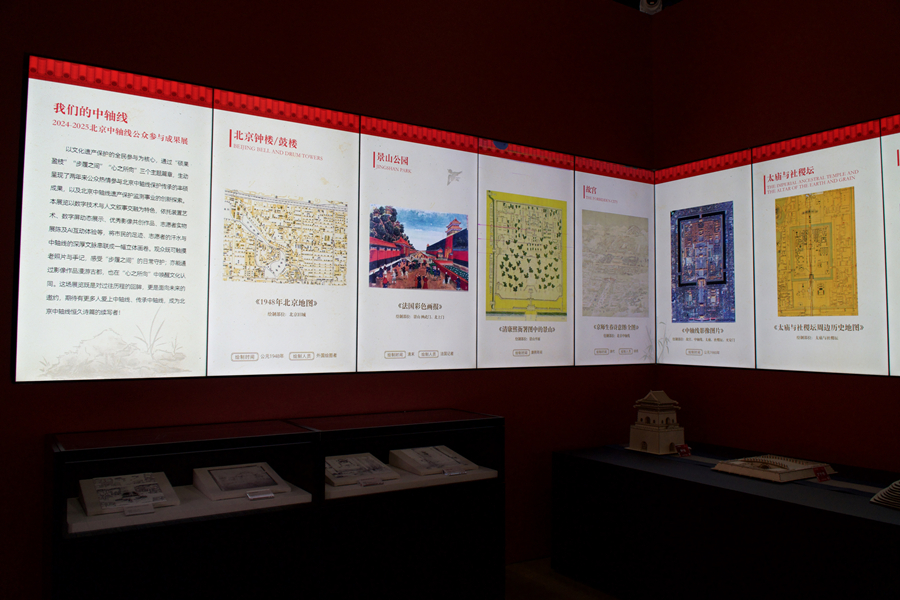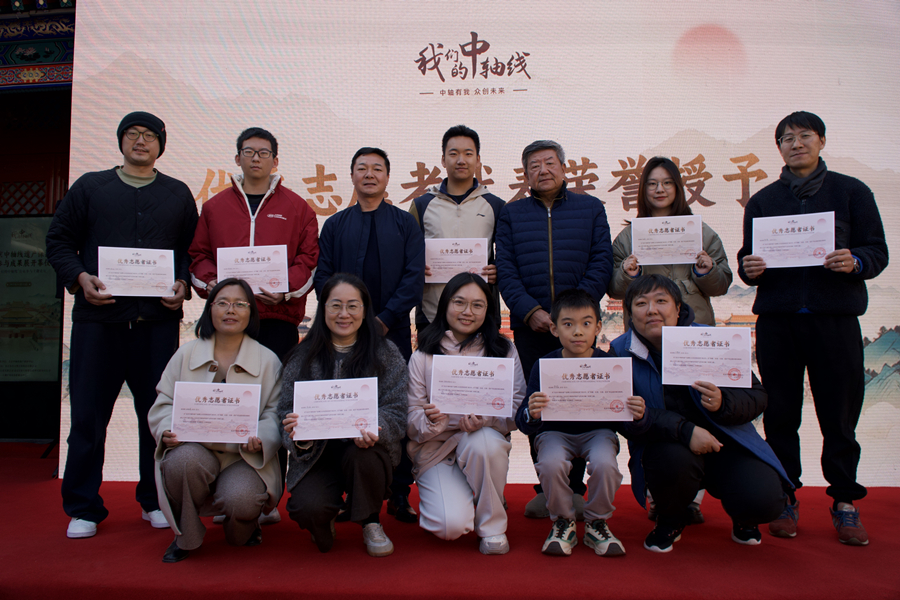
The opening ceremony of the Public Engagement Achievements Exhibition for the Beijing Central Axis takes place at Huguo Guanyin Temple, Beijing, Nov. 22, 2025. [Photo courtesy of Beijing WMWB]
The site, added to the UNESCO World Heritage List in 2024, has drawn increasing global attention, while the exhibition showcases how residents and volunteers are contributing to its ongoing preservation.
Stretching 7.8 kilometers from Yongding Gate to the Bell and Drum Towers, the Beijing Central Axis is the historic north-south line that has shaped the capital for more than 700 years.
UNESCO notes that the building ensemble, comprising former imperial palaces and gardens, ceremonial and sacrificial structures, administrative facilities, and public buildings, bears testimony to the evolution of the city and exhibits evidence of the imperial dynastic system and urban planning traditions of China.
The opening ceremony at Huguo Guanyin Temple in Beijing marked the launch of the Public Engagement Achievements Exhibition, hosted by the Beijing Central Axis Heritage Conservation Center and organized by Beijing WMWB Cultural Technology Co.
Deputy directors of the conservation center Li Bin and Liu Shan attended the event, with Li delivering remarks. Cultural heritage experts, volunteer representatives and media outlets were also present.
The exhibition provides a focused presentation of the results achieved over two years of public participation in protecting the Beijing Central Axis. It showcases how volunteers have contributed to on-site heritage monitoring, surveys of cultural sites, the co-creation of cultural content, and the broader communication of heritage values.
A key highlight is the Beijing Central Axis Collaborative Map, produced through a cultural mapping project in which volunteers documented cultural resources along the axis, with their findings then transformed into a hand-drawn-style cultural map. Participants also created micro-documentaries capturing stories and scenes associated with the heritage site.
In addition, the exhibition features the outcomes of a public photography initiative that invited citizens to record the cultural heritage of the axis through their lenses. Hundreds of submissions were received, with selected works awarded and displayed. A new promotional video summarizing the "Our Central Axis" program is also being presented, along with certificates for outstanding volunteers in 2025.

Historical maps highlighting the Beijing Central Axis are displayed inside the exhibition hall, Beijing, Nov. 22, 2025. [Photo courtesy of Beijing WMWB]

Award-winning photographs from the photography initiative are exhibited inside the hall, Beijing, Nov. 22, 2025. [Photo courtesy of Beijing WMWB]

Outstanding volunteer representatives receive honorary certificates during the ceremony in Beijing, Nov. 22, 2025. [Photo courtesy of Beijing WMWB]
Interactive displays in the exhibition halls visualize volunteer patrol routes, monitoring data and citizen-generated images that collectively document the condition of the 7.8-kilometer heritage line.
According to data released at the exhibition, the public engagement program has achieved significant impact. A total of 1,992 volunteers have taken part, completing 80,000 on-site inspections, recording 96,000 digital check-ins and uploading 179,000 photographs documenting the conditions of buildings, spaces and historic landscapes along the axis.
Digital platforms have further expanded participation: the Cloud Central Axis mini-program now has 1.1 million registered users, while the Digital Watchkeeper platform includes 29,000 registered volunteer inspectors. Over the past two years, 46 volunteer training sessions and 10 cultural activities have been organized, while volunteer-produced videos on social platforms have generated 8.27 million views.

Experts participate in the "Our Central Axis" forum on public engagement in cultural heritage protection in Beijing, Nov. 22, 2025. [Photo courtesy of Beijing WMWB]
A forum held after the opening ceremony brought together museum directors, scholars, media professionals, policy experts and volunteer representatives. They discussed the protection, communication, public participation and sustainable use of the Beijing Central Axis and other World Heritage Sites, offering insights that help deepen public understanding of how communities can participate in heritage conservation.
The exhibition will remain open until February 2026, allowing more residents and visitors to learn about the Beijing Central Axis and contribute to its preservation.


 Share:
Share: 




 京公网安备 11010802027341号
京公网安备 11010802027341号